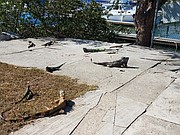Enjoying nature ... even on spring break
Spring break found me in Puerto Vallarta enjoying fishing, sightseeing, photography and discovering iguana. Walking around Los Penas marina in Puerto Vallarta one morning last week I couldn’t help but notice a group of people eying something on the pavement and grass between the boardwalk and the water. They were watching someone hand-feed hibiscus flowers to an iguana.
I recognized the lizard as a spiny-tailed iguana. There were around 12 of them sunbathing on the cement along the marina. The adult males were very aggressive, bobbing their heads up and down as I walked by them. I collected a handful of hibiscus from a nearby bush and fed them to the females, who were much more tame. It was a really cool experience! To see all the almost tame iguanas by the pier and waiting for people to give them a free lunch.
A fisherman in the area by the marina said that sometimes the males will bite if you get too close to them, and one gestured by shaking his hand as if he had first-hand experience with an aggressive iguana.
The word “iguana” is the Spanish derivation of the Carib (Amerindian) word “iwana,” a name given to a family of lizards that are found throughout the Americas. The entire order of reptiles has been traced back to Tianyusaurus who roamed the earth during the late Cretaceous period 65-100 million years ago.
Iguanas have been used as a food source in Central and South America for the past 7,000 years and are still used as a source of meat; often referred to as gallina del palo, “bamboo chicken” or chicken of the tree.” Leather from the iguana hide has also been a prized material for centuries.
Even though hunting, trapping, or killing iguanas is illegal throughout Mexico, they are nevertheless still sought after as pets. Aside from humans, iguanas have few natural predators; however, hawks and owls will attach the smaller ones. Since iguanas are preyed upon by hawks, their fear of hawks is exploited by blowing a hawk’s whistle, which makes the iguana freeze and become easier to capture in the wild.
Iguanas have claws and powerful tails to fight off most all other land based predators, and if caught, they have the ability to shed off a portion of their tail which will later grow back.
Iguanas are commonplace around the Puerto Vallarta area, living mainly in trees but also often seen bathing in the sun while on the ground or on large rocks. The tropical climate and lush foliage in Mexico provide the ideal environment for these ancient reptiles (as well as for us ancient retirees!); a never ending year-around supply of food with an abundance of leaves, fruit, and flowers such as hibiscus. As I witnessed on the grass and in the water, they are pretty fast runners and excellent swimmers!
The Mexican spiny-tailed iguana is a social lizard, which has adapted to living in groups as opposed to other species, which tend to be solitary animals. These iguanas are excellent climbers, and prefer a rocky habitat with plenty of crevices to hide in, rocks to bask on, and nearby trees to climb. They are diurnal and fast moving, employing their speed to escape predator but will lash with their tails and bite if cornered. They are often found dwelling near or in towns in their native Mexico and where they have been introduced elsewhere.
Juveniles consume a diet consisting mostly of insects. However, adults are primarily herbivorous, eating a variety of flowers, leaves, stems, and fruit, but they will opportunistically eat small animals, eggs, and arthropods. Male spiny iguanas grow to a length of 55 inches nose to tail while females grow to approximately 39 inches.
Well, it was an exciting spring break in Mexico, but it is fun to get back home in Boundary County.



